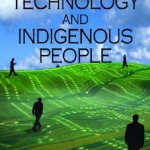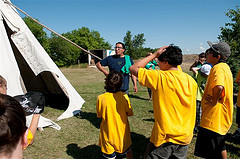Since the focus of my study is to examine how technology can bring cultural experience to students, in this module I focused on stories – both traditional and contemporary. Since the traditional stories are oral, I looked for websites with animated stories. As most contemporary stories will be written, I have tried to find sites that will help locate aboriginal literature.
1. Dust echoes
This site is a visual treat which provide visitors a very rich interactive experience of learning from the Aboriginal Dream Stories from Australia. The stories are illustrated using traditional native art with traditional music in the background. The site explains the origin of the stories and show where they originated on the Australian map. It provides study guides, quizzes. These quizzes do not have a simple yes or no answers but an explanation to support deeper reasoning.
The most interesting aspect on the site is an opportunity to create a mash up with the existing video. It also provides classroom resources for teachers. These resources are very detailed, not just about the activities, but with contextual information about the music and story. The site ensures that the teachers have in-depth understanding of what they will teach.
http://www.abc.net.au/dustechoes/
2. Stories of the Dreaming
This page is on the Australian Museum site. It explains the significance of such stories in the life of the Indigenous Australians. It explains how the Dream Stories do not belong to one individual but to a group or nation of people as these stories have been handed down through the generations. It explains that the elders are the ‘custodian’ of the stories of that people and that permission to re-tell the ‘Stories of the Dreaming’ can only be given by the custodian/s of each story, in consultation with their community. In the movie gallery there are movies of stories categorized according to the area of origin. The most meaningful aspect is that each story is accompanied by an explanation made by an elder from that nation. This makes the stories more meaningful and relevant to the viewers. There is also a written transcript about the story.
http://australianmuseum.net.au/Stories-of-the-Dreaming
3. Bunyip
This site uses the aboriginal myth of Bunyip to create an environment for the students to explore aboriginal stories and math, science, technology from the aboriginal perspective. In true fashion of oral tradition, Bunyip has continued to be a part of the Aboriginal and mainstream culture in the present day. The site beautifully shows this presence of Bunyip in the present and traditional culture. The reading level is not very high which makes the site more accessible to children of all age groups.
http://www.nla.gov.au/exhibitions/bunyips/flash-site/index-flash.html
4. First Nations Canadian Literature
This site showcases a lot of traditional and contemporary literature from the Canadian First Nations. The books are classified according to origin- Metis. Inuit, Pacific Northwest, but there is also a general section and sections for novels and graphic novel. When you click on the book, the site provides a brief synopsis of the book and the date of publication. The books range from picture books to chapter books for young adults.
http://www.kidsbooks.ca/department.aspx?DeptID=3700&
5. Canadian Literature: A quarterly of Criticism and Review
This site provides a dynamic list of Canadian publishers who publish both mainstream and Aboriginal Literature. It links to 15 publishers that publish in First Nations category. These links lead you to the publishers’ site where lots of work of Aboriginal authors is showcased. There are publishers like Totem Pole Books, Kegedonce Press, Oolichan, Pemmican Publication Inc. who exclusively print only FN material. Some also provide space for readers to interact through blogs.
http://canlit.ca/publishers.php?category=First_Nations

